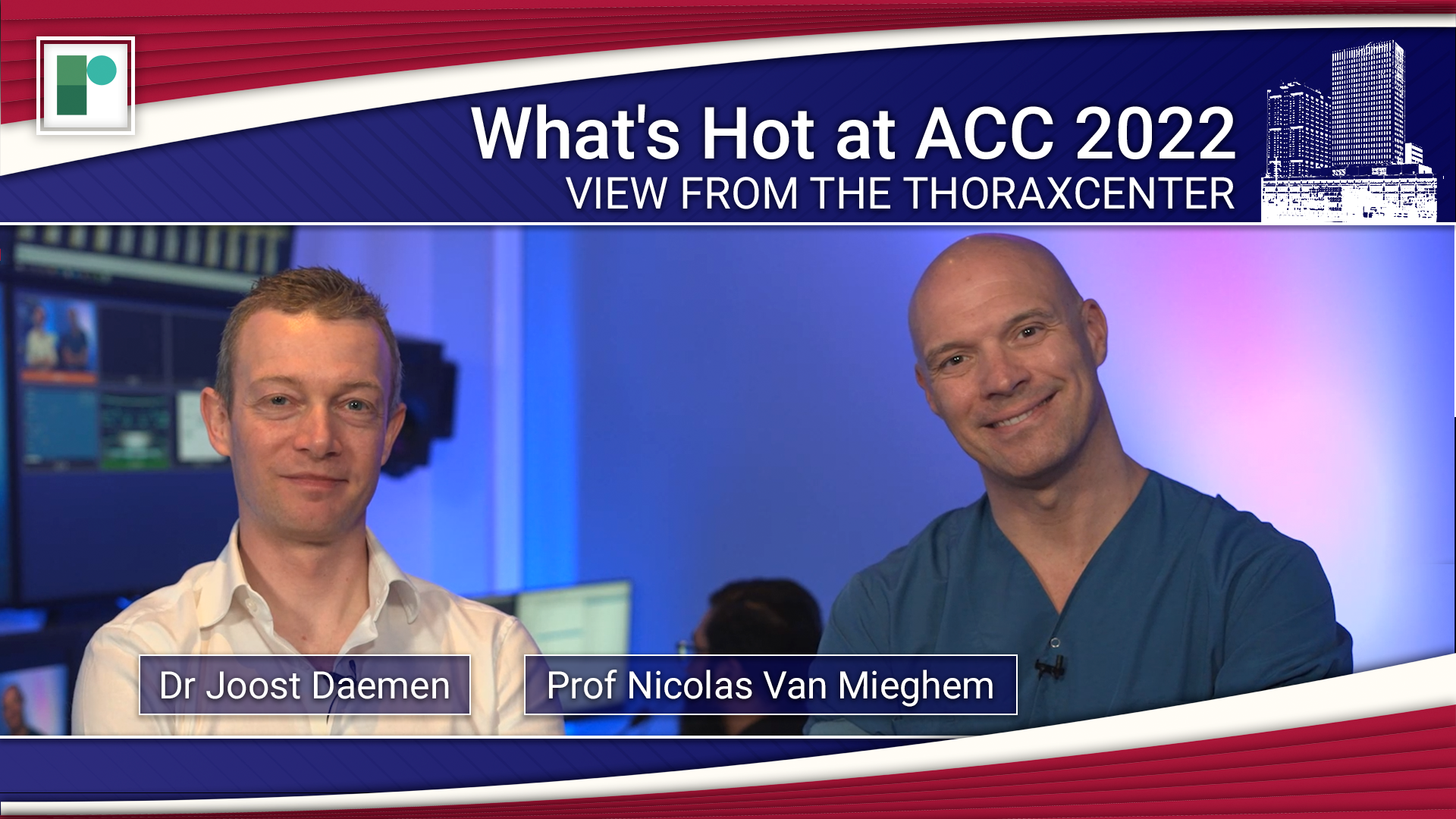ACC 2022: Late-breaking Science Video Collection
Published: 05 April 2022
-
Views:
 7932
7932
-
Likes:
 7
7
-
Views:
 7932
7932
-
Likes:
 7
7
-
 Up Next
Up Next -
 7m 44sPart 3 | Session 12 ACC 22: ADAPT-TAVR Shows SLT Does Not Affect CO for Patients After TAVR
7m 44sPart 3 | Session 12 ACC 22: ADAPT-TAVR Shows SLT Does Not Affect CO for Patients After TAVR -
 5m 41sPart 3 | Session 13 ACC 22: Results From the Chocolate-Touch Study
5m 41sPart 3 | Session 13 ACC 22: Results From the Chocolate-Touch Study -
 2m 25sPart 3 | Session 14 ACC 22: Results from the GIPS-IV Trial
2m 25sPart 3 | Session 14 ACC 22: Results from the GIPS-IV Trial -
 9m 27s
9m 27s -
 5m 35s
5m 35s -
 10m 24s
10m 24s -
 3m 50sPart 3 | Session 18 ACC 22: 3-year Efficacy Outcomes from the SPYRAL HTN-ON MED Med Pilot Study
3m 50sPart 3 | Session 18 ACC 22: 3-year Efficacy Outcomes from the SPYRAL HTN-ON MED Med Pilot Study -
 4mPart 3 | Session 19 2022 AHA/ACC/HFSA Guideline for HF Management: Highlights & Implementation
4mPart 3 | Session 19 2022 AHA/ACC/HFSA Guideline for HF Management: Highlights & Implementation
-
 12m 6sPart 4 | Session 1 ACC 22: 3 Trials That Will Change Your Practice with Dr Purvi Parwani
12m 6sPart 4 | Session 1 ACC 22: 3 Trials That Will Change Your Practice with Dr Purvi Parwani -
 6m 15s
6m 15s -
 7m 9sPart 4 | Session 3 4 Lipid Late-breaker Highlights from ACC.22 with Dr Erin Michos
7m 9sPart 4 | Session 3 4 Lipid Late-breaker Highlights from ACC.22 with Dr Erin Michos
-
 23m 9sPart 1 | Session 1 ACC 22 Late-breaking Science Preview Nicolas M Van Mieghem, Joost Daemen
23m 9sPart 1 | Session 1 ACC 22 Late-breaking Science Preview Nicolas M Van Mieghem, Joost Daemen
-
 28m 6sPart 1 | Session 2 ACC.22 Late-breaking Science Wrap-Up Nicolas M Van Mieghem, Joost Daemen
28m 6sPart 1 | Session 2 ACC.22 Late-breaking Science Wrap-Up Nicolas M Van Mieghem, Joost Daemen
-
 16m 42sPart 2 | Session 1 ACC 2022 Late-breaker Discussion: The SODIUM-HF Trial Justin Ezekowitz, Harriette Van Spall
16m 42sPart 2 | Session 1 ACC 2022 Late-breaker Discussion: The SODIUM-HF Trial Justin Ezekowitz, Harriette Van Spall
-
 16m 57sPart 2 | Session 2 ACC 2022 Late-breaker Discussion: The SuperWIN Trial Harriette Van Spall, Dylan L Steen
16m 57sPart 2 | Session 2 ACC 2022 Late-breaker Discussion: The SuperWIN Trial Harriette Van Spall, Dylan L Steen
-
 15m 38sPart 2 | Session 3 ACC 22 Late-breaker Discussion: The PROMPT-HF Trial Harriette Van Spall, Gregg C Fonarow, Tariq Ahmad
15m 38sPart 2 | Session 3 ACC 22 Late-breaker Discussion: The PROMPT-HF Trial Harriette Van Spall, Gregg C Fonarow, Tariq Ahmad
-
 22m 47sPart 2 | Session 4 ACC 22 Late-breaker Discussion: The DIAMOND Trial Harriette Van Spall, Javed Butler, Faiez Zannad
22m 47sPart 2 | Session 4 ACC 22 Late-breaker Discussion: The DIAMOND Trial Harriette Van Spall, Javed Butler, Faiez Zannad
-
 9m 38sPart 3 | Session 1 ACC 22: Findings from the VALOR-HCM Trial Milind Y Desai
9m 38sPart 3 | Session 1 ACC 22: Findings from the VALOR-HCM Trial Milind Y Desai
-
 7m 19sPart 3 | Session 2 ACC 22: MAVA-LTE Shows Improvement in NYHA Class in Patients Treated with Mavacamten Florian Rader
7m 19sPart 3 | Session 2 ACC 22: MAVA-LTE Shows Improvement in NYHA Class in Patients Treated with Mavacamten Florian Rader
-
 3m 19sPart 3 | Session 3 ACC 22: Results From the PACIFIC AF Trial Manesh R Patel
3m 19sPart 3 | Session 3 ACC 22: Results From the PACIFIC AF Trial Manesh R Patel
-
 3m 6sPart 3 | Session 4 ACC 22: FAME 3 Suggests CABG Outperforms FFR-Guided PCI in Patients with Multivessel Disease Frederik Zimmermann
3m 6sPart 3 | Session 4 ACC 22: FAME 3 Suggests CABG Outperforms FFR-Guided PCI in Patients with Multivessel Disease Frederik Zimmermann
-
 3m 54sPart 3 | Session 5 ACC 22: Results from the TRANSLATE-TIMI 70 Trial Brian Bergmark
3m 54sPart 3 | Session 5 ACC 22: Results from the TRANSLATE-TIMI 70 Trial Brian Bergmark
-
 4m 22sPart 3 | Session 6 ACC 22: Results from the POISE-3 Trial Philip J Devereaux
4m 22sPart 3 | Session 6 ACC 22: Results from the POISE-3 Trial Philip J Devereaux
-
 6m 30sPart 3 | Session 7 ACC 22: ICD Shock Therapies and the Burden of Ventricular Tachycardia Paolo Della Bella
6m 30sPart 3 | Session 7 ACC 22: ICD Shock Therapies and the Burden of Ventricular Tachycardia Paolo Della Bella
-
 6m 3sPart 3 | Session 8 ACC 22: PACMAN-AMI Shows Reduced Plaque Regression in AMI Patients Treated with Alirocumab Lorenz Räber
6m 3sPart 3 | Session 8 ACC 22: PACMAN-AMI Shows Reduced Plaque Regression in AMI Patients Treated with Alirocumab Lorenz Räber
-
 3m 31sPart 3 | Session 9 ACC 22: Magnitude & Duration of Effects of a siRNA Targeting Lp(a) Steven E Nissen
3m 31sPart 3 | Session 9 ACC 22: Magnitude & Duration of Effects of a siRNA Targeting Lp(a) Steven E Nissen
-
 4m 48sPart 3 | Session 10 ACC 22: Results From a sub-study of the POISE-3 Trial Maura Marcucci
4m 48sPart 3 | Session 10 ACC 22: Results From a sub-study of the POISE-3 Trial Maura Marcucci
Overview
Our regular review series View from the Thoraxcenter hosted by Prof Nicolas Van Mieghem and Dr Joost Daemen (Thoraxcentre, Erasmus MC, Rotterdam, NL) provide a concise analysis of the late-breaking science results and spotlight impactful data.
For a deeper dive into key clinical trial data, Dr Harriette Van Spall (McMaster University, Hamilton, CA)talks with principal investigators in her regular Late-Breaker Discussion Series.
Short, accessible Expert Interviews were conducted with select faculty focusing on the results, applicability, and impact on future research.
More from this programme
Part 1
View from the Thoraxcenter
Part 2
Late-breaker Discussion Series
Part 3
Expert Interviews
Faculty Biographies

Michael J Reardon
Dr Michael J. Reardon holds the position of Clinical Professor of Cardiothoracic Surgery at MD Anderson Cancer Center and created the multi-institution, multidisciplinary cardiac tumor team with HMH and MDA.
He has served as elected president of the medical staff for the HMH and received numerous awards including the Overstreet Award and Noon Award. He currently holds the Allison Family Distinguished Chair of Cardiovascular Research and divides his time between building innovative clinical, research and educational programs.
Transcript
Rationale of the Study
As we all know, TAVR's become an established treatment of a, a severe aortic stenosis, and because of a family of randomised trials we've run, it's now been approved at all risk levels. In fact, risk is no longer part of our guidelines. Therefore we're seeing younger and healthier patients in our clinics being considered for TAVR. Therefore, it's very important for us in advising these patients, to know between TAVR and surgical valve, what's the rate of structural valve deterioration, and if you get structural valve deterioration, what are the clinical outcomes of that? This study answers those questions.
Study Design and Patient Cohort
The study design, is we took the CoreValve High-risk, and SURTAVI randomised cohorts, which is over 2000 patients. We used a randomised cohort to compare the difference in structural valve deterioration between surgical biologic valves, and TAVR using a CoreValve or an Evolut. We then added the non-randomized continued access arm to get to almost 5,000 patients, and use this larger number to look at the outcomes and the predictors of structural valve deterioration.
Key Findings
The most interesting findings, are that that surgery has more structural valve deterioration than TAVI. It's something that most of us would not have initially predicted, and that this is accentuated in people that have a small annulus, less than 23 millimetres by CT scan, such as women or smaller, smaller people. We also found that if you did develop structural valve deterioration, whether you've had a surgical valve or TAVR, it basically doubled your risk of death, and doubled your risk of hospitalisation. We also found that people that tended to get structural valve deterioration, with those with a larger body surface area, women, younger patients, and patients that are healthier.
Influence on Clinical Practice
These results will influence clinical practise in a number of ways. My patients come in everyday, that are often candidates for both surgery and for TAVI. And they want to know, basically what they should have. And one question is, is how likely is the value you put in me, to develop dysfunction at some point? And if it does develop dysfunction, how is this dysfunction going to affect my health and wellbeing? This study helps answer those questions, and helps us make good decisions for our patients when they come to see us.
Next Steps
Well, the next steps are that this is a five year study. The SURTAVI, the intermediate risk trial, and the Evolut low risk trial will both be followed over 10 years. And we'll gather this data at 10 years, and this longer term follow up will further inform the field, our patients and practitioners, how best to make these decisions.
Take-home Messages
The take home message is, if you have, if you're at a high or intermediate risk for surgical aortic valve replacement, and you get surgery or TAVI using a quarter of Evolut super annulus self expanding valve, your TAVI valve will have less structural valve deterioration than any of the surgical valves used in the trial. If you get structural valve deterioration, whether you have a TAVI or surgery, it doubles your risk of mortality, it doubles a risk of hospitalisation. We also see that is, this is accentuated in smaller annuluses. So people like women, do much better.





